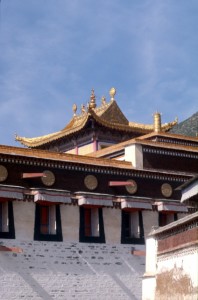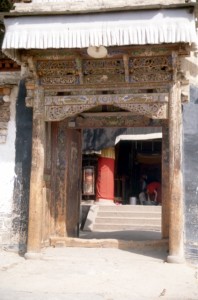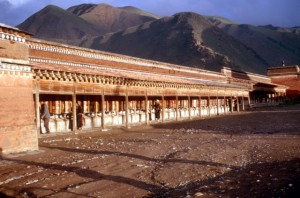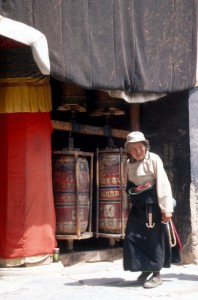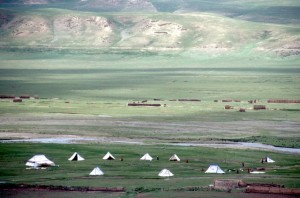About bus travel, and a visit to the Labrang Monastery in Little Tibet.
In Linxia we connected with transport to Xiahe, home of the most famous Tibetan Monastery outside Tibet, the Labrang Monastery. We missed the 09.00 am bus, the next morning, so we got on the 09.30. There is an advantage of being early, on Chinese buses, as you can choose you seat. However, when we left the bus station, we were only with six passengers, and we had the uneasy feeling that the bus would not make the trip to Xiahe for the six of us alone. These buses are designed for something like 20 people, and the bus driver was clearly unhappy with the small pay load. And indeed, he spent the next hour driving through town, literally from one end to the other, then turning around, trying to pick up more passengers. A Chinese bus usually has a crew of two, one driver and one bus attendant, and both try to attract the attention of unsuspecting passers-by. The driver will almost continuously blow the horn, whilst the attendant hangs half out of the bus door, shouting “Xiahe Xiahe” all the time, at the top of his voice, trying to outdo the blaring horn. Most efficient, obviously, because after a while the bus contained well over 20 passengers, plus the necessary carton boxes, rice bags, bound-together suitcases and whatever else people use to carry their stuff around. At one stop we even picked up six dead sheep, which were hauled on the roof, and kept leaking blood across the rear window for the rest of the trip. On the way the bus broke down only once, and all in all we arrived in Xiahe almost five hours after departure, having covered a mere 100 km.
The Labrang Monastery is one of the most important proponents of the Order of the Yellow Hat. Confusingly, however, none of the monks, currently some 3000, wear this type of head-gear, instead they all have pink robes. And they are very obvious, very visible everywhere, in shops, in restaurants, on the back of motorised tricycles that serve as taxis, or behind the wheel of a Japanese four-wheel drive, like the private driver of the Head of the Monastery. Buddhism is not forbidden in China, the constitution actually protects officially recognised religions, as well as minorities. The difficulty comes when recognising a reincarnation, the process used by Buddhist to ensure continuity of religious office. The Tibetan believers will have identified the reincarnation of one or another of their important office bearers, but the state-supported Chinese Buddhists generally have decided to recognise a different infant, which leads to significant confusion, no doubt fueled by the politicised nature of the religious argument. The staff of the monastery was not very forthcoming in discussing this issue, but I suppose that amongst real believers the Chinese have some catching up to do, as they did lose credibility during the Cultural Revolution, when three-quarters of the monastery of Labrang was destroyed.
The best hotel in town is still a rather Spartan affair, some three kilometres outside the village, and originally built as a hostel for new monks, with small rooms around a beautiful little courtyard. It is a lovely place, despite the fact that the official hours for hot water, from seven to nine in the evening, are somewhat flawed (actually, we did not have much hot water the first night, and only boiling hot water the second). For transport into town one is dependent on renting bicycles, by the hour or by the day.
Touristically, Xiahe has two attractions. First, of course, there is the Monastery, which can be visited in a guided tour. The highlight of the tour is invariably lunch time, when all the monks gather first at the steps of the main prayer hall, chanting and singing for almost half an hour, before entering the hall itself. Inside, despite the enormous size of the monastery, everything seems very well organised, very smooth. Hundreds and hundreds of monks populated the main area, where they chanted, and were served food. In rooms at the side elder monks gathered, at least partly to satisfy the hundreds of ordinary folk, and tourists, that streamed into the prayer hall. The temple, like others on the complex, also contains a number of enormous yak butter sculptures, which are being prepared every year, during special festivals, and may be kept for ten years or more. They are very intricate, but the one thing nobody tells you about, is their smell. Imaging ten-year old butter?
The second attraction is the grass lands beyond the village, an area where yaks, sheep, cows, and horses graze solitary, or in herds. Pastures are endless, undulating across the hills as far as the eye can see, and that is quite far. We chartered a motorcycle to get to there, but one could just as well rent a bicycle, definitely a more peaceful way to see the surroundings. Somewhere on the way one passes underneath an arch, and in China that always means that you have to pay. Unbelievable, but somebody has decided that the grass lands beyond Xiahe are touristic, and therefore one needs to pay entrance fee.
No facilities provided, nothing different from undeveloped pastures elsewhere, just an opportunity to make some money, and it is official, you actually get a printed ticket. Some kilometres further some camps had been erected, populated by horses, for rent, and by people whose business it was to get you on one of those horses. Politely declining does not work well here.
The disadvantage of Xiahe is that to get away again, one needs to backtrack to Lanzhou, which is a solid eight-hour bus trip.
Continue: Travel to Zhanye


